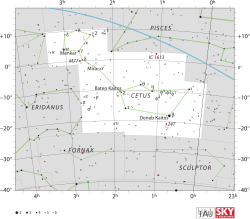Sigma Ceti
| Sigma Ceti (σ) | |
 | |
| Observationsdata Epok: J2000.0 | |
|---|---|
| Stjärnbild | Valfisken (stjärnbild) |
| Rektascension | 02t 32m 05s[1] |
| Deklination | -15° 14′ 40,8278″[1] |
| Skenbar magnitud () | +4,78[2] |
| Stjärntyp | |
| Spektraltyp | F5 V[3] eller F4 IV[4] |
| U–B | -0,03[2] |
| B–V | +0,45[2] |
| Astrometri | |
| Radialhastighet () | -27,5 ± 0,9[5] km/s |
| Egenrörelse (µ) | RA: -80,21[1] mas/år Dek.: -146,29[1] mas/år |
| Parallax () | 37,46 ± 0,25[1] |
| Avstånd | 87,1 ± 0,6 lå (26,7 ± 0,2 pc) |
| Absolut magnitud () | +2,68[3] |
| Detaljer | |
| Massa | 1,21[6] M☉ |
| Radie | 1,5[7] R☉ |
| Luminositet | 7,6[8] L☉ |
| Temperatur | 6,527 ± 59[9] K |
| Metallicitet | -0.12 ± 0.04[9] dex |
| Vinkelhastighet | 20[3] km/s |
| Ålder | 2,135[6] miljarder år |
| Andra beteckningar | |
| σ Cet, 76 Ceti, BD -15° 449, FK5 1071, HD 15798, HIP 11783, HR 740, SAO 148445.[10] | |
Sigma Ceti (σ Ceti, förkortat Sigma Cet, σ Cet) som är stjärnans Bayerbeteckning, är en dubbelstjärna belägen i den sydöstra delen av stjärnbilden Valfisken (stjärnbild). Den har en kombinerad skenbar magnitud på 4,78[2] och är synlig för blotta ögat där ljusföroreningar ej förekommer. Baserat på parallaxmätning inom Hipparcosuppdraget på ca 37,5[1] mas, beräknas den befinna sig på ett avstånd av ca 87 ljusår (ca 27 parsek) från solen och är sannolikt en astrometrisk dubbelstjärna.[11]
Egenskaper[redigera | redigera wikitext]
Primärstjärnan Sigma Ceti A är en gul till vit stjärna i huvudserien av spektralklass F5 V[3]. Malaroda (1975) tilldelade den emellertid spektralklass F5 IV[4], vilket betyder att den skulle kunna vara en mer utvecklad underjättestjärna. Den har en uppskattad massa som är ca 20[6] procent större än solens massa, radie som är ca 1,5[7] gånger större än solens och utsänder från dess fotosfär ca 8[8] gånger mera energi än solen vid en effektiv temperatur på ca 6 500[9] K.
Källor[redigera | redigera wikitext]
- Den här artikeln är helt eller delvis baserad på material från engelskspråkiga Wikipedia, tidigare version.
Referenser[redigera | redigera wikitext]
- ^ [a b c d e f] van Leeuwen, F. (2007), "Validation of the new Hipparcos reduction", Astronomy and Astrophysics, 474 (2): 653–664, arXiv:0708.1752 , Bibcode:2007A&A...474..653V, doi:10.1051/0004-6361:20078357.
- ^ [a b c d] Mermilliod, J.-C. (1986), "Compilation of Eggen's UBV data, transformed to UBV (unpublished)", Catalogue of Eggen's UBV data, (PDF) origin: SIMBAD, Bibcode:1986EgUBV........0M
- ^ [a b c d] Takeda, Yoichi; et al. (February 2005), "High-Dispersion Spectra Collection of Nearby F--K Stars at Okayama Astrophysical Observatory: A Basis for Spectroscopic Abundance Standards", Publications of the Astronomical Society of Japan, 57 (1): 13–25, Bibcode:2005PASJ...57...13T, doi:10.1093/pasj/57.1.13.
- ^ [a b] Malaroda, S. (August 1975), "Study of the F-type stars. I. MK spectral types", Astronomical Journal, 80: 637−641, Bibcode:1975AJ.....80..637M, doi:10.1086/111786.
- ^ de Bruijne, J. H. J.; Eilers, A.-C. (October 2012), "Radial velocities for the HIPPARCOS-Gaia Hundred-Thousand-Proper-Motion project", Astronomy & Astrophysics, 546: 14, arXiv:1208.3048 , Bibcode:2012A&A...546A..61D, doi:10.1051/0004-6361/201219219, A61.
- ^ [a b c] David, Trevor J.; Hillenbrand, Lynne A. (2015), "The Ages of Early-Type Stars: Strömgren Photometric Methods Calibrated, Validated, Tested, and Applied to Hosts and Prospective Hosts of Directly Imaged Exoplanets", The Astrophysical Journal, 804 (2): 146, arXiv:1501.03154 , Bibcode:2015ApJ...804..146D, doi:10.1088/0004-637X/804/2/146
- ^ [a b] Pasinetti Fracassini, L. E.; Pastori, L.; Covino, S.; Pozzi, A. (February 2001), "Catalogue of Apparent Diameters and Absolute Radii of Stars (CADARS)", Astronomy and Astrophysics (3rd ed.), 367: 521–524, arXiv:astro-ph/0012289 , Bibcode:2001A&A...367..521P, doi:10.1051/0004-6361:20000451.
- ^ [a b] McDonald, I.; et al. (2012), "Fundamental Parameters and Infrared Excesses of Hipparcos Stars", Monthly Notices of the Royal Astronomical Society, 427 (1): 343–57, arXiv:1208.2037 , Bibcode:2012MNRAS.427..343M, doi:10.1111/j.1365-2966.2012.21873.x.
- ^ [a b c] Prugniel, Ph.; et al. (July 2011), "The atmospheric parameters and spectral interpolator for the MILES stars", Astronomy & Astrophysics, 531: A165, arXiv:1104.4952 , Bibcode:2011A&A...531A.165P, doi:10.1051/0004-6361/201116769.
- ^ "sig Cet -- Double or multiple star", SIMBAD Astronomical Database, Centre de Données astronomiques de Strasbourg, hämtad 2017-02-09.
- ^ Eggleton, P. P.; Tokovinin, A. A. (September 2008), "A catalogue of multiplicity among bright stellar systems", Monthly Notices of the Royal Astronomical Society, 389 (2): 869–879, arXiv:0806.2878 , Bibcode:2008MNRAS.389..869E, doi:10.1111/j.1365-2966.2008.13596.x.





